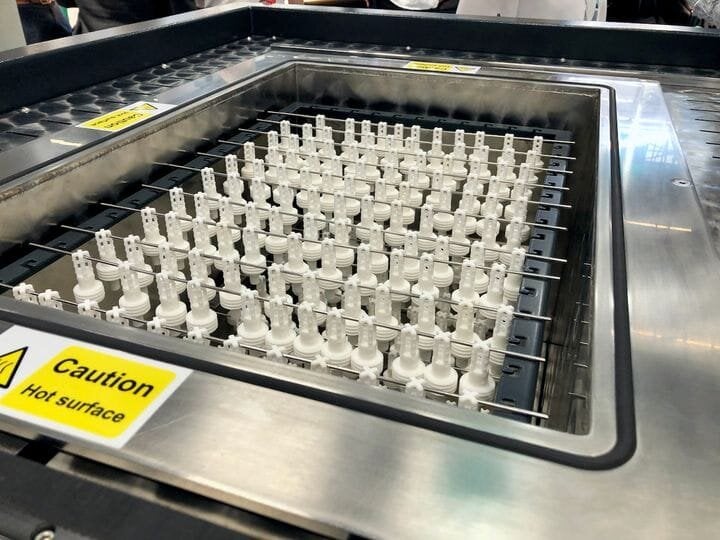![3D prints about to be smoothed in AMT’s PostPro3D system [Source: Fabbaloo]](https://fabbaloo.com/wp-content/uploads/2020/05/amt-smoothing-1_img_5eb08cd34030b.jpg)
One of the many post-processing vendors present at Formnext 2019 was startup company AMT.
The company hopes to capitalize on the increasing need for automating the usually labor-intensive post processing steps required for many types of 3D prints. Service bureaus in particular need to lower their operational costs to the absolute minimum, and one common angle is to decrease expensive manual steps through automation.
AMT, based in Sheffield, UK, now employees some 45 staff, and has offices in Texas and Asia. Their products are solely directed towards the post processing market, and their goal is to enable manufacturers to scale operations efficiently and predictably.
3D Print Vapor Smoothing
![Comparison of smoothed (left) and “raw” (right) 3D prints [Source: Fabbaloo]](https://fabbaloo.com/wp-content/uploads/2020/05/image-asset_img_5eb08cd37e71d.jpg)
The core technology in their product line is a method of vapor smoothing, in which freshly 3D printed objects exhibiting layer lines are chemically smoothed by a precise exposure to a gas. This exposure delicately softens the exterior skin of the 3D prints and creates a smooth surface without layer lines. Smoothing also can create a completely air-tight surface layer, removing the surface porosity and gaps that plague 3D prints produced layer-by-layer.
I’ve seen this process previously, having used Stratasys’ Smoothing Station. However, using that device was quite challenging to use because it was entirely manual to operate. You would “dip” a print into a reservoir of clear smoothing gas. If I recall, it was toxic, as well.
The major problem in doing this process manually is that you are never sure how long to expose a print. If too short, it’s not smooth. If it’s just a bit too long, you may have ruined the print.
AMT Post Processing Automation
![AMT’s PostPro3D Mini system [Source: Fabbaloo]](https://fabbaloo.com/wp-content/uploads/2020/05/image-asset_img_5eb08cd3c3811.jpg)
Those problems are gone with AMT’s process, which is automated. You can choose a “recipe” from their library for a variety of materials and geometries, and the equipment then takes on the role of ensuring the precision exposure parameters are executed. AMT’s equipment controls the pressure, temperature and timing of the exposure. This should result not only in good quality parts, but also done on a very consistent basis from batch to batch.
AMT told me that their process works with “all thermoplastics”, whereas most other vapor smoothing approaches I’ve seen are somewhat restrictive to certain materials. For example, the acetone process works only on ABS and similar styrene-based materials. AMT says even flexible materials can be successfully smoothed in their equipment, and material color is retained.
AMT Solvent
![A look at solvent piping in AMT’s PostPro3D system [Source: Fabbaloo]](https://fabbaloo.com/wp-content/uploads/2020/05/image-asset_img_5eb08cd412d4c.jpg)
How do they do this? They can’t be using the same solvent as Stratasys. It turns out that AMT has a brilliant solution. They explained that they use an organic solvent from the medical industry in their system. This means that the particular solvent is already certified for use and in fact they expect to receive FDA approval by the end of this year.
AMT explained that they can also color prints by mixing in paints with the organic solvent. Thus the prints can be deeply colored and smoothed at the same time. The resulting color is not merely painted on the surface, but is embedded in the print to some degree due to the softening of the material, making the coloration quite durable.
AMT Pricing
Two versions of AMT’s post processing system are available, a standard unit for US$75,000, and a “mini” unit of smaller dimensions for only US$25,000.
![AMT’s robotic post-print sorting system dropping a part into the red bin [Source: Fabbaloo]](https://fabbaloo.com/wp-content/uploads/2020/05/image-asset_img_5eb08cd45c742.jpg)
It seems that AMT is working on other aspects of post processing. They say they are developing a depowdering unit that is “coming soon”. They are also developing a robotic system for physically moving and sorting completed prints. Here you can see a prototype of this system, where a print is being dropped into a particular bucket.
AMT is a new company, but seems quite successful, and not just with customers. They’ve recently raised a significant US$5.2M Series A investment round, which will no doubt fund the development of future products and allow them to continue developing a sales network.
Via AMT

